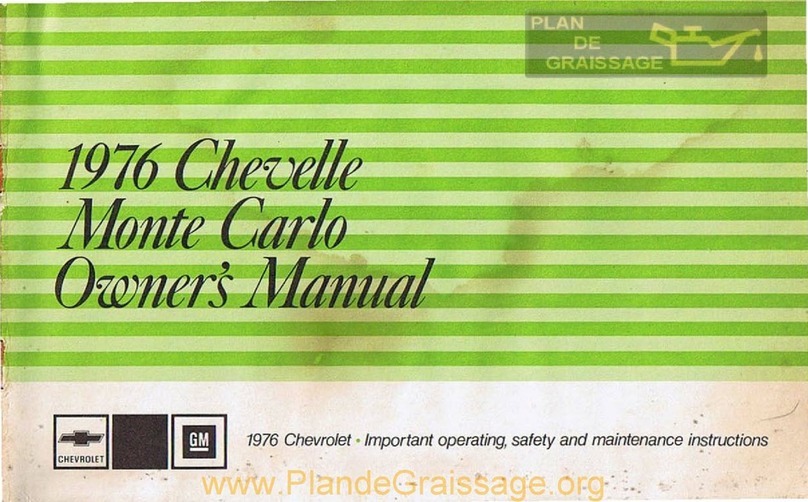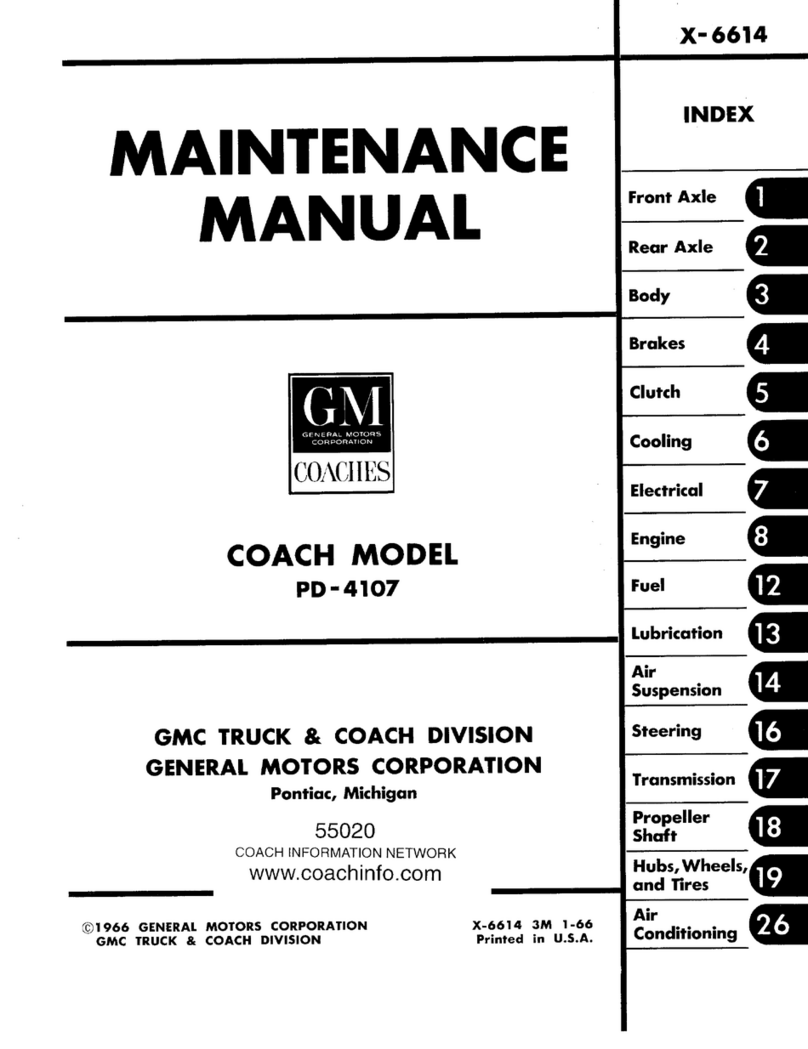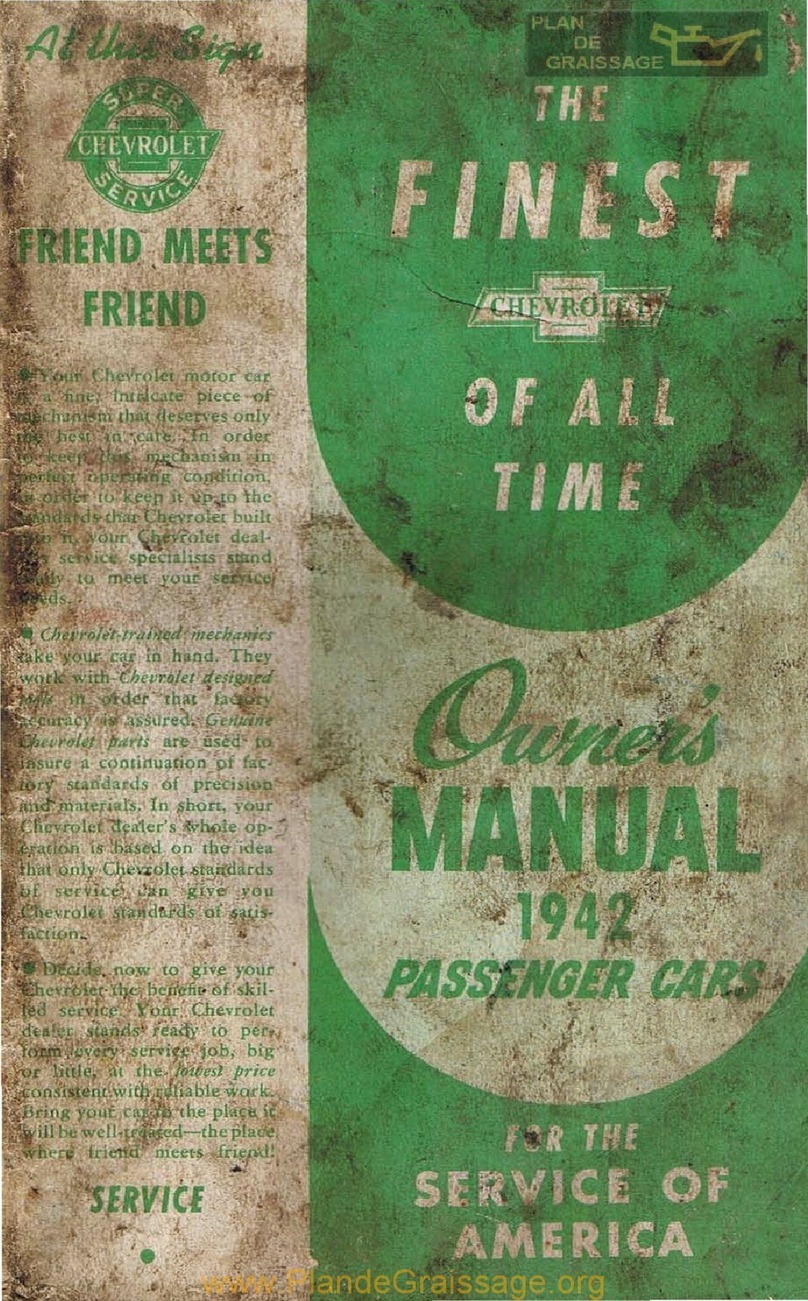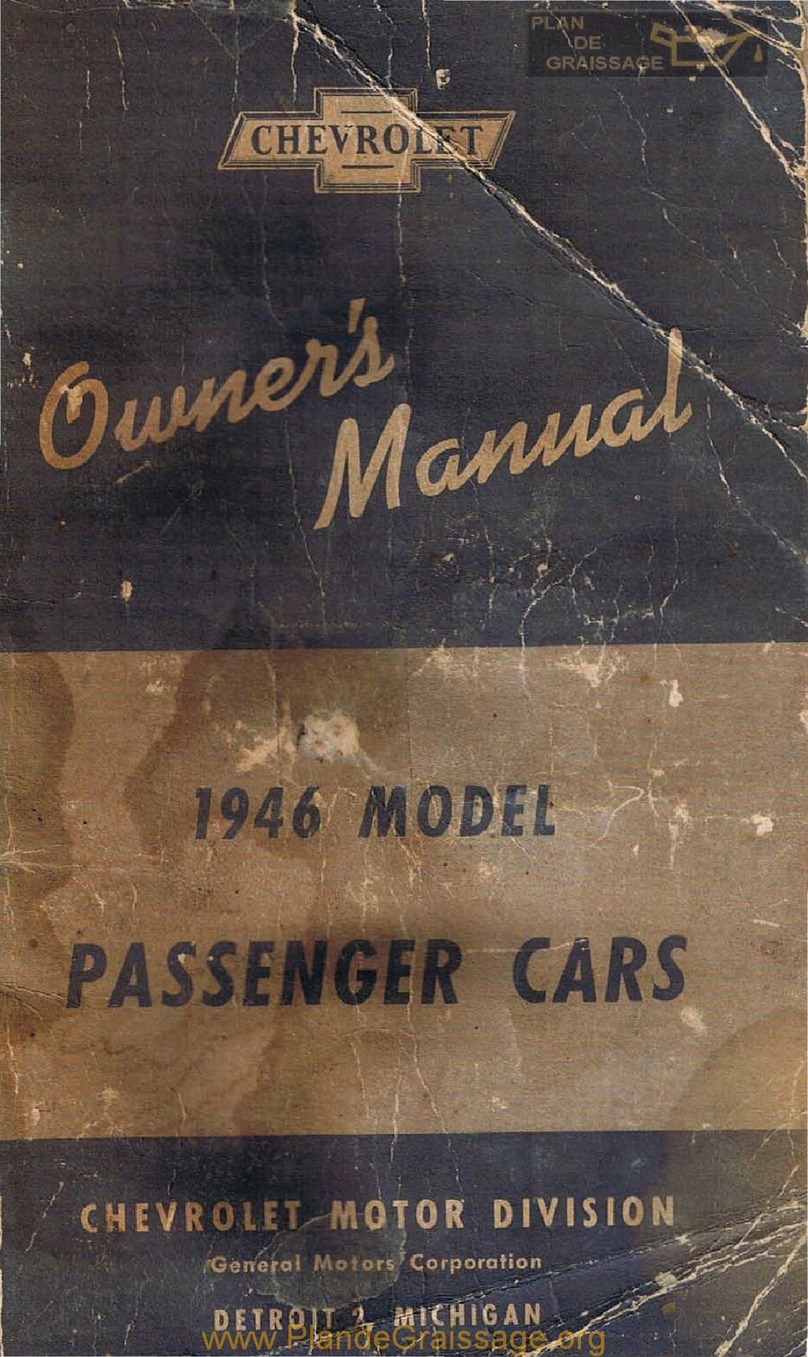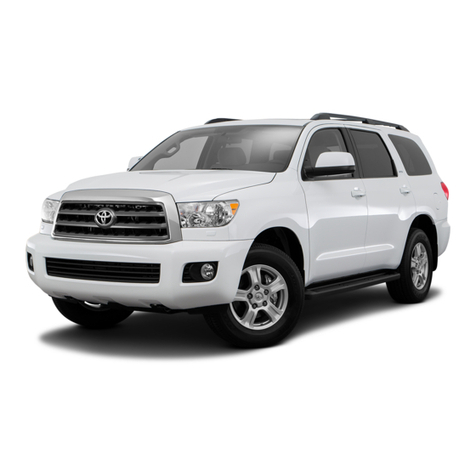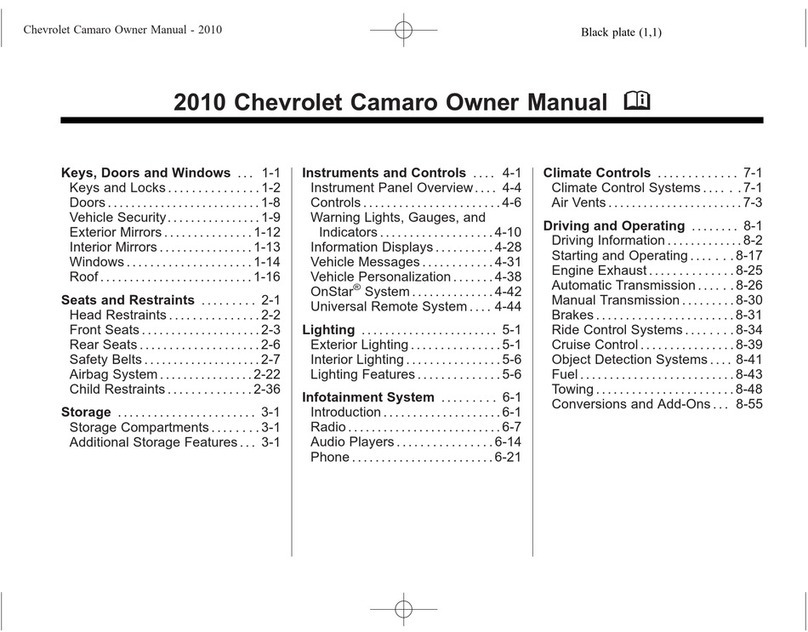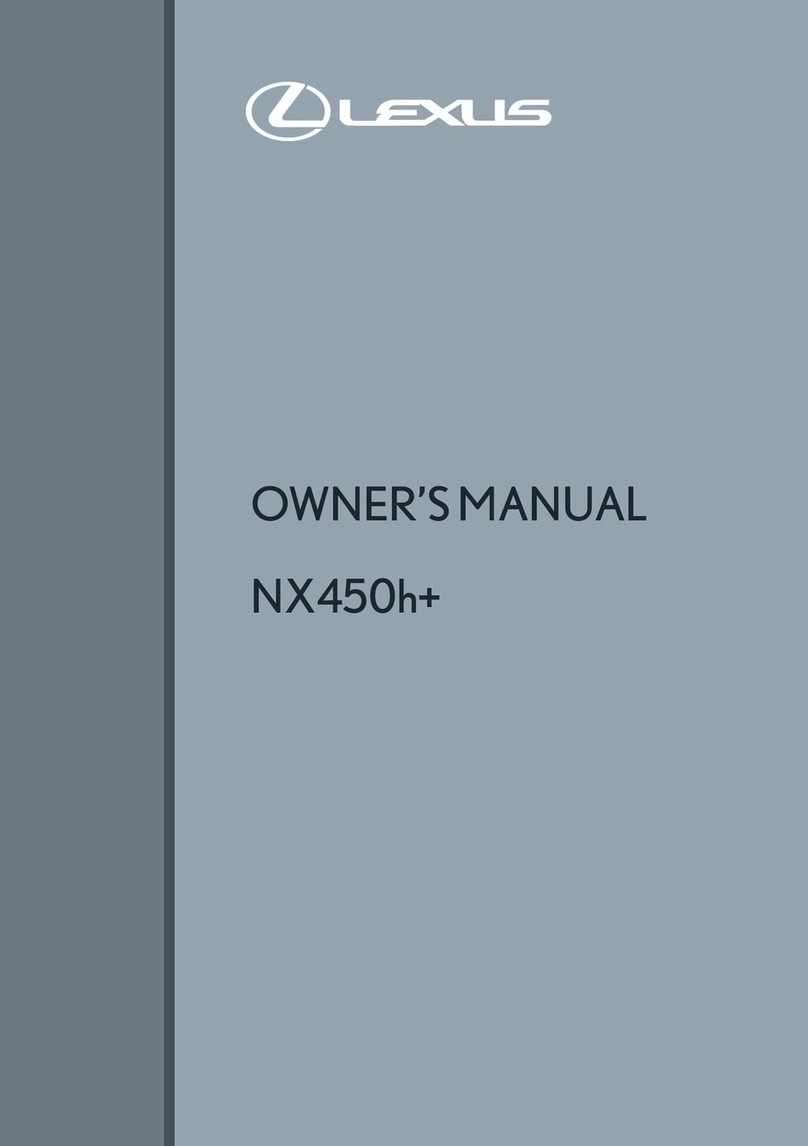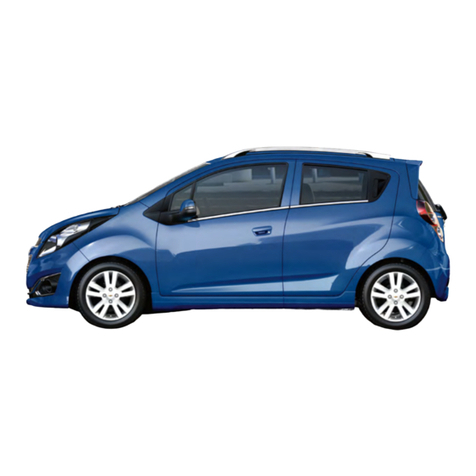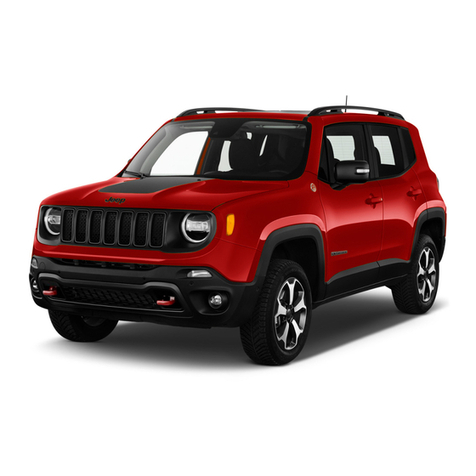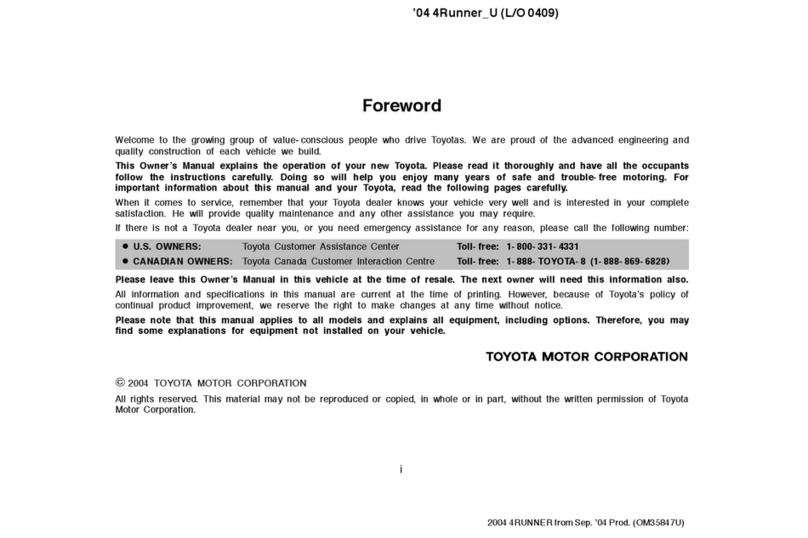GM PONTIAC 1966 User manual

---
C
NER'S
GUICE
IMP
0 RTAN
T:
This
Owner',
GUide
contains
~'all1ahle
InformatIOn
on
the
proper
care
and
operation
of
your
new
car.
Please
read
all
Items
carefully
www.PlandeGraissage.org

A
Word
of
Welcome
From
General
Motors
..
.
This Owner's Guide contains
important
information
regarding
the
operation
and
maintenance
of
your
Pontiac.
In order to obtain
maximum
enjoyment
and
usage from
your
car,
we
suggest
that
you
familiarize
yourself
with
the
contents
of
this
booklet
and
follow
the
recommendations
outlined.
Your
Pontiac dealer has
the
trained personnel
and
specialized equip-
ment
to properly service
your
Pontiac. Have
him
inspect
your
car
and
perform
any
maintenance
or
adjustments
required.
We
would
like
to
take
this
opportunity
to
thank
you
for choosing a
Pontiac
product
-
and
assure
you
of
our
continuing interest
in
your
mo
toring pleasure and satisfaction.
GENERAL
MOTORS
PRODUC
TS
OF
CANADA,
LIMITED,
OSHAWA,
ON
TARIO
www.PlandeGraissage.org

Prinl. d in Conod
..
S..sS (M.P.)
1966
PONTIAC
OWNER'S
GUIDE
Po.! No.
3393257
fiRST
WITtON
CONTENTS
SECTION
I- Operating your Pontiac
__
.
__
._
__
__
__
_ . 2 Ihru 9
10
Ihru 12
13
Ihru 20
SECTION
SECTION
SECTION
2-
ln
SlrumcnlS _ ....._______.
___
....__.
__
3-Controls
_
__
..
__
....._....
__
.........
____
.._
__
__
4--
Other
Features ._"_.
_____
...
_____
.
__
.......
...._._...
21
thru 23
SECTION
5-Slation
Wagons ......
___
......
__
...__.
__
..__ 24 thru 26
SECTI
ON
6--Convertible .
__
...
____
.
__
.
___
.
__
...
____
.
__
.
__
26
SECTION
7- Maintenance and Lubrication
Recommendations ...__
__
_
__
______ ........_....__"
__
27 Ihru 42
SECTI
ON
SECT
I
ON
8-Acccssories
__
'0_'
••••••
__
••
_._
••••
__
•
__
•••••
_.
___
43
Ihm
47
9- Recommcnded Appearance Care .
________
.
__
. 48
Ihm
51
SECTION
100Minor
Trouble Shooting Guide
._._.
__
._
..
_
_.
__
._
52
thTU
56
SECTION I I- Technical Data
_._.
____________
.
__
._
_.
_
__
57 thru 59
All
information
COlltai
ned ill this
booklet
is based on the latest product
in/ormation available at the time
of
printillg_ The right is reserved
to
make
changes
at
any time wi/hour
liD/ice_
Mon<io,,-
635
s._
Georg
o
SI_
Mon"
.ol-
5000
N. ...
M",opol;Ion
Bl.d., Pte
Cia;,.,
Quo.
Toronlo-611 Rkhmond 51.
E.
london_Box
3~12,
Term;nal
'"A'"
lONE
OFFICES
Winn;
P"9-13~5
R
o-d
....
ood
A•• .
Re
g
;no_8Ih
A.
..
&
lo,o"
'o SI.
C"lgary-(220
BI<>ek
fool T,,,;I,
ao~
2510
Vo
n
touYOf-900
Torminal
Av
o.
www.PlandeGraissage.org

SECTION
1 -
Operating
your
Pontiao
--------------
BREAKING
-
IN
PERIOD
The
precision
manufacture
of
your
new Pontiac has elim-
inated
the
need for tedious low speed driving
during
the
break-in period. However, it
is
advantageous
to
the
life
of
aU
close-fitting
parts
to limit speed
to
a
maximum
of
50
miles
per
hour
for
the
first 100 miles and not
over
60
miles
per
hour
for the next
400
miles. Sustained high speed
or
constant
speed driving should be avoided until the
mileage schedule has been completed.
If most of
your
driving
is
of the
around
town variety.
which
is
considered "severe service", espe<:ially in cold
weather, be sure
to
include some 25 mile
or
longer high-
way trips
during
the
breal,:.in period and vary your speed
When you accelerate and decelerate, you load
and
unload
the moving parts, helping them to seat properly.
When
starting
out
with a cold engine, a great deal
of
wear
can
be
avoided by driving at a moderate speed until the engine is
thoroughly warm.
In tbe early life
of
the engine it
is
normal for
the
engine
to use some oil. It may be necessary to
drive
the
car
at
least
4,000
miles
to
allow the rings to seat properly.
An
engine·s oil economy should
not
be judged until it has been
properly ··run-in".
Remember,
during
the first few
hundred
miles
of
driv-
ing, avoid high speed stops and frequent
or
severe
brake
application to permit a
proper
break-in period for
your
brakes.
DRIVING
FOR
ECONOMY
Proper
maintenance and wise operation will
combine
to help you achieve maximum fuel economy with
your
Pontiac.
Your
Authorized Pontiac Dealer
can
properly tune
and maintain
your
car but wise operation
is
your
responsi-
bilit
y.
Give the
ear
sufficient warm-up time,
do
not
make
··ruB-throttle" starlS
or
needless sudden stops, and drive at
reasonable speeds and as steady as traffic permits
to
gain
the benefits
of
all the economy built into yo
ur
Pontiac.
WARNING-CARBON
MONOXIDE
2
"Avoid Inbaling u
hau
st ga
srs
,,
-
heD
any concentration
of
tbese
Is
prese
nt
In the
lI
ir
,
I.
e. In
II
g
ara
ge, In con
grs
ted traffic. or
wben stopped d os
el
y behind
II
.-e
hid
e with its mutor
runnin
g.
Emaust
ga
ses may b
aH
strong odors
,,
-bieb normally sbQuld
gb e warning of
tb~ir
presence. 1I0w
ue
r, the
uh
aust gases from
s
om
e vehicles m
~y
not be
n
otice~
bl
e
und
er
certain con
di
tions
and
tbe UnSrs
of
people react differentl)'. };"haust
gas~s
co
n-
ta
in
a percentage of
car
b
on
munox
id
e ,..hieb iJ
II
poisonous
gas that, by
It
self, Is
t
3s
t
e
l
~ss.
colorless, and odorless.
Ne
ver
start
or
run
eng
in
e in
II
dose
d
garage.~
www.PlandeGraissage.org

IGNITION
SWITCH
Th
e 4-position ignition switch
located on the lower edge
of
the
in
strument
pan
el to the
right
of
the steering column
is operated
by
the octagonal
shaped k
ey_
The
ignition
switch is
OFF
when the key
i
~
vertical,
ON
when the
ke
y
is
turn
ed
ri
gh
t to
fi
rst posi-
tion, START when
ke
y is
turn
ed
to
full right position
against stop and ACCES-
SORY
wh
en key
is
pushed
"in"
and turned
to
the left.
The
Accessory position enables you to operate all elec·
trical accessor
ies
that are controlled through the swit
ch
with
out
having the engine running or the ignition switch
in the
"ON"
position.
The
key
can
only be removed in
th
e
straight-
up
"O
FF
" position.
On vehides equipped with an automat
ic
transm
iss
ion
the key starter switch
is
inoperative unless
th
e
se
l
ec
tor lever
is
in
.oN"
or
"
P"
posi
ti
on.
If
engine
is
very cold or
car
is
on
hi
ll
, "P" position is preferable.
STARTING
THE
ENGINE
I.
AUTOMATI
C
TRA
NSMISSI
ON
-
Pl
ace
se
lector lever
in N
or
P posit
io
n. The engine will not start when
lever is
in
any oth
er
position.
MANUAL
TRA
NSMISSION- Place gtarshift contr
ol
lever in Neutr
al
and depress clutch pedal
to
the floor.
2. IN ITIAL
Sf
ART
(a)
Engine Cold- Depress accelerator pedal to floor
and release. This presets the automatic cho
ke.
(b) Engine Hot
Or
In Extremely Cold Weather
(0
0 F
and below)-Dcpress accelerator pedal part way
down and hold while slarting the engine.
3.
Turn
ignition switch
to
S
TART
and release as soon as
engine starts.
4. "
FL
OO
DED
·' ENGI
NE-
Depress accelerat
or
pedal
10
Hoor and hold
whi
le cranking engine.
Nevu
"pump"
accelerator pedal.
WARM·UP
Alwa".
Itt
Ibt
~
IM
Idle
fOl"
•
IDOIDIlDI
01" M O
attn-
staI1Iq
aa'
.h
t at moderate spet<b
fOl"
M1'tnl
mae..
Kptdal
ly
duriq
colel wu
dtn'
, 10
pre"eal
~
wear
10
tU
eDIine
....
Ie
.....
~_
3
www.PlandeGraissage.org

DRIVING
WITH
THE
PONTIAC
MANUAL
TRANSMISSIONS
Thre
e-
Spe
e d
Manual
Tran
s
mission
Th
e 3-Spced
full
y
5y
nchroni~ed
manual transmi
ss
ion is
standard equipment on a
ll
models. It incorporat
es
three
forward speeds
and
reverse.
The
shift pattern for the
5ync
h
roni~ed
trans
mi
ss
ion
is
the familiar
··
H
··
pattern as
illustrated. Since the transmission is fully
sy
nchronized
in
all forward spt!eds. you may downshift into first gear at
any spe
ed
below 20 M.P.H.
For
smooth.
cmdcnt
transmission operation, the follow.
ing detailed shift procedures are recommended.
FIRST
GEA
R ( LOW) -Depress the clutch pedal, shi
ft
into
firs
t, and smoothly release the clutch pedal while
simultaneously pressing on the accelerator pedal. First
gear should always be used
to
st
an
the
car
moving. In
the event the car
is
completely stopped and it
is
difficult
10 shift into first. release the clutch momentarily and then
shift into first.
Gear
motion
is
required
to
r the
sy
nchro-
nizer to work properly.
SECOND
GEA
R - As the car gains speed, depre
ss
the
clutch pedal, release the accelerator and
move
the gear.
shift lever into second gear. Release the clutch pedal and
depress the accelerator pedal as above.
Av
oid starting
from a stop in
sc<:o
nd
gear
as
this practice may cause
clutch slippage, thereby reducing clutch life.
4
T
HI
RD
GEAR
(HIG H) - As the
ear
continues
to
gain
more speed, shift
in
to third in the
manner
described above.
Slowly release the clutch pedal
and
depre
ss
the accelerator
pedal.
Th
ird gear
is
the cruising ge
ar
for
a
ll
normal driv-
ing.
NEVE
R u
se
third gear
to
accelerate from a S
lOp.
TO
STOP -Release the accelerator pedal
and
depress
the brake pedal. Just before the ear stops, depress the
clutch pedal along with the brake pedal
and
move the
gearshift lever into Neutral.
NEUTRAL - F
or
usc when starting
or
idling the ear.
Never coost
in
Neutral.
REVERSE -Operate Reverse as
fi
rst gear but always at
a slow speed.
The
car
must
be
brought
to
a complete Sl
Op
beforc shifting into Reverse. o
o e
www.PlandeGraissage.org

Four
-
Speed
Manual
Transmission
Th
e four-speed fully
sy
nchronized manual transm
iss
ion is
optional on all model
s.
It has four
full
y
sy
nchronized for-
ward speeds and one non·synchronized rever
se
speed with
a shift panern as shown
in
the illustrat
io
n on page 4.
S
HIFT
I
NG
THE
TRA
NS
MISSI
ON
-
Fi
rst gear is se-
lected by depress
in
g the
cl
utch pedal
and
moving t
he
Icver
to first gear, the No. I po
si
t
io
n. Since t
he
foor-speed
s)'nchro-mesh is fully synchronized on all forward speeds
you may downshift
in
to
firs
t gear at any speed below 20
r-.I.P.H. Move the shift lever easil
y,
delaying slightly
to
allow the transmi
ss
ion synchronizers
to
coordinate gellr
speeds. When shifting
in
to "Reverse" gear, lift
up
on
the
reverse release cable handle just below the shift lever knob.
T
he
shift linkage may be adjusted to a
ll
ow "shorl strok
e"
sh
ifl lever operation. See your Pontiac Dealer.
For
aC1Ual
shifting procedure, follow the instructions
given for the three-speed manual trans
mi
ss
ion on page 4.
Pushing
to
Start
Your manual trans
mi
ss
ion
equipped car can
be
started
by
pllshing
in
an emergency.
Uo
...
e
~e
r,
do
e
10
th
e
po
ss
Ibi
l
it
y of
dam
age
to
brig
ht
meta
l c
hr
ome
p~rt
s,
thi
s
pr
ac
t
ice
I.
Dot
r
e~
o"''''
c
nd
ed.
I.
Turn
off all electrical lo
ad
s,
such as radio, heater a
nd
,
if possible, the lights.
2.
Turn
on
the ignition k
ey
and depress the clutch pedal.
J. Place the gearshift l
ev
er
in
second
or
third gear.
4. When the car reaches approximately 15 M.P.H
.,
s
lowl
y
rclease the clutch. After the engine starls, depress the
clutch pedal and run tbe engine
at
fast idle until warm.
Then
pr
oceed as n
orma
l.
5. Ext
ra
effort will be required
10
operate power steering
and power brakes until the engine st
ar15.
Manual
Tran
s
mis
s
ion
Op
er a
ting
Caution
s
I.
DQ
not
"spud
shift",
allow time bet
we
en
sh
ifts for
trans
mi
ss
ion synchronizers to coordinate.
2. 0 " not u
sc
secoJld, third or f
ourth
gears
to
acce
le
rate
from a stop.
3.
Always place gear
se
lector
in
Neutral and
se
t the foot
brake when starting the engine.
4. Never "r
ide"
the clutch pedal as this
will
cause ex-
cess
iv
e
sl
ippage with r
es
ult
an
t wear on the clutch parI.
5. Never leave vehicle unattended' with the engine run-
ning.
6. Always
se
t parking brake firmly before leaving the car.
7.
Do
not coast
in
neutra
l.
5
www.PlandeGraissage.org

DRIVING
WITH
THE
POWERGLIDE
AUTOMATIC
TRANSMISSION
The
Po
....
erglide
is
a completely automatic transmission
which replaces the standard clutch and transmission. After
starting the engine
wi
th the selector lever
in
N
(Neutra
l)
or
P ( Par
k)
position, select the range desired (see table
below) and depress the accelerator. A gradual start with
a steady increase
in
accelerator pressure will result in
best possible fuel c<:onomy. Rapid acceleration for fa
st
starts
will
result
in
greater fuel consumption.
P_'AIlJC U
..
only
...
hu
ca,
i.
....
pp.d
"l
ifT
---1--
-~----~
-----
"UfT
----1--------------
N_NtUTltAl
O_ORIV£
f
o,
n~,<1
pullin~
Ih,ou~h
.~nd,
.
nO
....
0'
",ud,
ood 10, climbing
0,
d
..
".dinl
.I
••
p
gr~d
...
00
no
••
hill
10
"I"
~bo
••
'0
",ph.
lor
f~,
...
~,d
O,i"';nl.
O.p'."
o«.le,olO.
10 1100'
lor
ox"o
o«.I.rorio.
below
..,
",pn -V-li
40
",ph
- 1-6.
"L
IfT
__
-j
__
-'-
__________
_
L- LOW
"L
illing
de
.." .I
op'
1110
1
p,e.en
l unin
....
ionol
,hih
.
10
Pork,
Low
or
R
.......
6
Coluznn
ShUt
Lever
The
heavy line in the
ill
ustration below indicates the
movement
of
the shift lever as
it
is
lifted
to
shirt
inlO
Re-
ve
r
se
or
Low and into
or
out
of
Park position.
Floor
Console
Shift
Lever
The
floor console shift lever may
be
moved freely
be·
tween Neutral
and
Drive. Press lightly on the shift·lever
bullon
as
you shift into Reverse
or
Low.
Dep
ress the
button fully when shifting into or
out
of
Park
position.
Exercise care
in
depressing the shi
ft
lever bUllon to p
re
-
vent unintentional shifts to P
ar
k, Low or Reverse
www.PlandeGraissage.org

DRIVING
WITH
THE
TURBO
HYDRA
·
MATIC
TRANSMISSION
Th
e Turbo H
yd
r
a-
Matic is a completely automatic three-
speed transmission. After
staning
the engine with the
sele<:
tor lever
in
/'II
(Neutral) or P
(Park)
position,
)"ou
need only
to
se
l
e<:
t the range desired (see t
he
table below)
and
depress the accelerator. A gradual start with a steady
increase
in
aCi:e
ler
ator
pressure will result
in
be
st possible
fuel econom
y.
Rapid acceleration for fast starts
will
result
in
greater fuel
co
nsumption.
~U::R
'
:'
__
-l-
--=":
"
~
'
:
"
~
'
~
':":'~'
:
'
~
'
~
;,~,:",
:'
.:d
~
'
:
'~":;
:
"'
:,::"
.:':,"
~
d
.
~U::V~":':'_
-l---=
":"':':'·:'C'-:::·:;"~·~":'
~
":·:·~":"~
·
___
_
N_
N(UTIU.I
D
DRtV!
fo.
lorward
d.....
,"II.
O'p
....
<>«
.....
010.
10
1100.
10
•••
,.0
_
.....
o.Oon
bel
....
6$
M'
,""
d.p,
...
0<-
'lifT
----I-~
'.
~
.
~
'"
:.:
'
~
.
:
.'
:
'
~
'
:
"
~
'
=
'
~
'
=
""
='~""::::':..:"::::M~,":
.
_
L
,-
IOW
.
Fo.
d.i.inO
in
h
.a"l'
I.affi.
o.
on hilly ••
"oin.
Shift into L. o.
On,
••
hid
••
pH d .
fo,
ho,d
pullin~
throu~h
.ond,
.now
or mud
ond
fer
<limbinll
o.
d
..
un
dinll
"HP
orad
...
'Lif.inll
d.o"
.top
••
hot
p"
.
.....
1
""in""lio"
..
1
.hilt.
'0
'o.k
,
....
..
. .
low
,
Of
low,
.
ColuDlD
Shift
Lever
The
heavy line
in
the illustrations below indicates the
movement
of
the shift lever as it
is
lifted
to
shift into
Reverse
Of
Low,
and
into or out
of
Park position.
Floor
COD
s
ole
Shift
Lev
e r
The
Hoor console shift lever may be moved freely between
Neutral and Drive and between Low, and Low
,_
Pre
ss
lightly
on
the shift lever bulton
as
you shift into Reverse
or
Low,. Depre
ss
the button fully
wh
en
shifting into
or
out
of
Park position. Exercise care
in
depressing button
to
prevent
un
intentional shifts
to
Park, Low,
or
Reverse.
PARK
RNDL.L,
7
www.PlandeGraissage.org

AUTOMATIC
TRANSMISSION
OPERATING
TIPS
Pushing
to
St
a
rt
Powerglide
Turn
off all electrical loads such as radio, heater and, if
possible, lights until the engine starts.
With the ignition key turned
ON
and the transmission
in
N
(neutral),
allow
the
car
speed
to
reach 25
to
30
miles
per
hour
,
Then
shift the transmission to L (low) po
si
tion,
After
the
engine starts, the transmission may be opetated
in
the normal manner, Never tow the
car
to s
tart
.
Extra
ellort
will be required to operate power steering
and
power
brakes until the engine start
s.
T
...
rbo Hydro-malic
The
Turbo
Hydra-Matic transmission
is
designed so that.
the engine cannot be started by pushing the car. Should
the battery become discharged
it
will
be necessary
to
use
an auxiliary battery with jumper cables to start
the
engine.
When connecting the auxiliary battery be especially care-
ful
to
observe the correct polarity to prevent damage to
the De1cotron,
Parking
Your
Car
Always engage the parking brake and place the transmis-
sion se1edor lever in
"Park"
position when leaving
your
car
unattended.
ROClking
th
e
Car
If
it becomes necessary
to
rock
the
car
to
free it from sand,
mud
or
snow, move the selector lever from
"0"
to
"R"
in a repeat pattern while simultaneously applying moder-
ate pressure to the accelerator.
For
this purpose "R" posi-
tion may be engaged
at
speedometer readings below 5
m.p,h.
Do
not
race engine, Avoid spinning wheels when
trying
to
free the
car
from sand. mud or snow.
If
the
car
is
still stuck after a couple
of
minutes
of
rocking, have the
car
pulled
out
of
the ruts
to
prevent
overheating and possibly damaging
the
transmission.
Towing
The
car
may be towed safely
on
its
rear
wheels with
the
selector lever
in
"
N"
(Neutral) position
at
speeds
of
3S
miles
per
hour
or
less under most conditions.
However, the drive shaft must be disconnected
or
the
car
towed on its front wheels if I ) T
ow
speeds
in
excess
of
35 miles
per
hour
are necessary, 2)
car
must be towed
for extended distances
(ove
r
50
miles)
or
3)
transmission
is
not
operating
pr
operly.
If
towing the
car
on its
frODt
wheels. the steering wheel should be secured
to
maintain
a straight ahead position.
www.PlandeGraissage.org

A
utornatic
Tr
a
nsmission
Operating
T ip s (
Con
t
'd)
Ho
lding
Car
On
An
Upgrade
When stopped on an upgrade, maintain your position by
applying the brakes. Never hold the
car
in place by ac-
celerating engine. This could cause damage by overheating
the transmission.
Eco
norny
Note
Ponti~c
owners have a choice of good performance with
economy
or
superb performance. Good fuel economy may
be obtained by making normal starts and
not
attempting
maximum acceleration at all times,
If
, however, you desire
maximum performance on every start. you must eKpect
less fuel economy.
COLD WEATHER NOTE
In
cold WINdier tile "nciM .Dd
tnu.nbslon
011
..01
Dot
flow 11$ naotiIy
..
wlam W.n!_
'I
..
Importut
therefore tbIIt tIM
eacIDt:
be
opentnl
fOl'
• few
mill-
ut
a
Won:
'
puctbqr:
the
(ar
in
JIlOCioD.
To
m.re
apintt
..,....hIre
blhn
of
etdMr
fIHI
__
gine 01'
tn_1sdoa
after
....
IaJtiIIl
dart
III ntremeb"
cold
wn dler
It
b ncomme.ded
...
,
nl
phI
~
titan
be
...
oIded
WItII dllII' • few ....
Ies
of
~.
DRIVING
WITH
THE
POSITRACTION
REAR
AXLE
The
positraction
rea
r axle will give you constant driving
force on both
rear
wheels, especially helpful in
the
winter
and during other slippery driving conditions which might
stop a conventionally equipped vehicle. During turns, the
positraction axle applies the major driving force
to
the
inside rear wheel thus improving stability and cornering.
Normal light throttle application will supply maKimum
traction. When starting with one rear wheel on an ex-
cessively slippery surface, slight application
of
the
pa
rking
brake may be necessary momentarily
to
gain maximum
traction.
9
www.PlandeGraissage.org

SECTION
2 -
InstruDlents
-------------------
The instruments, gauges and warning lights conveniently
located
in
the instrument panel
are
designed
to
teU
you
at
a glance many important Ihings about
the
performance
of
your
car. The information
on
this and the following
p
age
will
enable you
10
more quickly understand and
10
properly interpret these instruments. Familiarize yourself
with their location and purpose
and
make
it
a practice
10
scan the instrument
duster
as
you start the engine, after
it
starts, and periodically
as
you drive.
RADIO SPEAKER
"-
_ _m_
o"
00'
ASH
TRAY
AND
LAMP
www.PlandeGraissage.org

FUEL
GAU G~
This
gauge indicates the a
ppr
oximate fuel level in
the
tank
Qnly when
the
ignition switch
is
\I,Irned on.
When
the
ignition swit
ch
is
\I,Irned off,
the
pointer
may
come
10
rest at any position
on
the dial.
TACHOMETER
A tachometer is availahle
a5
standard
equipment with the
fOUT speed synchromesh transmission. Its
purpos
e
is
to
indicate engine speed in revolutions
per
minute (R.P.M
.)
The red hand
can
be manually set as desired to give the
driver an indication
of
his
maximum
power point which
should never
be
exceeded.
AMMETER
GAUGE
The
ammeter
gauge located in
the
centre
of
the ins
tr
ument
panel indicates battery charge
or
di
scharge.
If
the pointer
should indicate discharge while driving.
alher
than
at idle
speed.
or
at very slow driving while lights and accessories
are
operating, take
your
car
to an
aU1hori~ed
Pontiac
Dea
l
er
for servicing. Whcn the battery
is
close
to
fully
charged the
ammeter
gauge will indicate very low rate
of
charge.
11
www.PlandeGraissage.org

ENGINE
OIL
PRESSURE
INDICATOR
LIGHT
The red light located
to
the
right
of
the
odometer
in
the
instrument
duster
will
appear
when
the
ignition switch is
turned on. When the engine starts and oil pressure builds
up,
the
light
will
go out. This signal light is an oil press
ure
indicator
-no
t an oil
le
vel
gauge. Should the light go on
while
the
engine
is
running,
stop
the en
gi
ne and
hD.I'e
the
cause determined and
corre<:
ted.
Dr
iving the
car
with low
oil pressure
ca
n cause serious engine damage.
SPEEDOMETER
AND
ODOMETER
The
speedometer indicates the speed of the
car
in
miles
per
hour
, The odometer,
or
mileage indicator, registers
accumulated mileage and
is
useful for checking trip mile-
ages, maintenance periods
and
fuel consumption.
Engine remporgture light
12
ENGINE
TEMPERATURE
INDICATOR
LIGHT
A red signal
lisht
located
on
the instrument
duster
will
appear
momentarily when slarting the car
to
le
t you know
that it
is
oper
ating.
The
only other time
the
si
gnal light
should
appear
is when the engine reach
e5
an
abno
rmally
high temperature. If Ihis happens,
the
engine should be
stopped and
the
cause determined and
cor
rected.
HEADLIGHT
HIGH
BEAM
INDICATOR
Whell the headlights are on high beam, an indicator light
below the 60
~
II'H
in
the instrument cluster glows red.
Never Icavc the high beam on when approaching oncom-
ing traffic.
The
Headlight Dimmer
Swi
tch controls
the
headlight beams (Sec Page 14) .
Pr
e
..
ure light
www.PlandeGraissage.org

SECTION
3 -
Controls
TURN
SIGNAL
INDICATOR
The
turn
signal lever
is
mounted
on
the left side
of
the
sleering column. The
turn
signal lever should be moved to
the ·
·up"
position to signal for a right
turn
and
to
the
"down"
position for a left turn. This activates flashing
signals
on
the right
or
left. both front and
rear
of
the
car,
to
inform
oncoming
and following drivers
of
the direc-
tion you intend
to
turn. Flashing lights (right and left)
on
the instrument cluster indicate
the
direction
for
which
the signal is being made. When the
turn
is
completed, the
lever will return
to
neutral automatically.
If
the indicator light remains
on
and does not flash,
it
i.
'I
evidence of a burned
OUI
turn
signal bulb at either the
front
or
rear
on
the side indicated.
For
safety, and
to
comply with the law, have burned out bulbs replaced at
once.
I
~
,,
~~
<~
~~
;
HEADLIGHT.
INSTRUMENT
PANEL
AND
DOME
LIGHT
SWITCH
The
control knob for the headlights, parking lights, and
instrument panel lights,
is
located in the ins
trument
cluster
to the left
of
the speedometer.
HEADLIG
H
TS
are
oper-
ated by pulling the switch control knob
all
the
way out.
PARKING
LIG
HT
S come
on
as the
same
knob
is
pulled
halfway out. I
NSTRUMENT
PANEL
LIGHTS
are
on
in
both positions. Instrument panel lights can be increased
or
decreased in intensity,
or
turned
off, by rotating
the
control knob. To operate
dome
light,
turn
switch
knob
fully counterclockwise.
13
www.PlandeGraissage.org

HEADLIGHT
DIMMER
SWITCH
The
headlight dimmer switch permits you
to
se
le
ct the
correct headlight beam for different types
of
drivin,g. To
obtain high
or
low beam depress
the
foot
dimmer
switch
located on the floor just below
the
parking
brake
pedal.
A red light located below
the
60
MP
H in the instrument
cluster appears when you are driving
on
high beam. Always
usc "Iow beam" when approachi
ng
or
fo
ll
owing other
vehicles.
COURTESY
LIGHTS
Th
e
cour
tesy lights
in
your car, if so equipped, illumina
te
the front compartment of the
car
when either front d
oor
is
opened. When the front doors are
dosed.
full counter-
clockw
ise
position
of
the headlight control knob turns
on
Ihe courtesy lights.
BACK
-
UP
LIGHTS
F
or
safe
ty
and convenience. your Pontiac
is
equipped
with dual back-up lights thai go
on
automatically when
Ihe transmission gearshift lever
is
placed
in
the "Reverse""
p-osition with the ignition switch on.
LIGHTING
SYSTEM
TROUBLE
CHECKS
If
the instrument
p~nel
li
ghts are
in
operative, check both tbe
tuil
li
ght fu
se
and
the
In
strument pllnel
fOSl'.
• When the
tum
signal indicator
comt!
00
but
does not flasb,
check for burned out
tum
sig
m,1s
or stop lamp
or
5N'
If
tb
e
w,on
g flash
er
Is being u
se
d•
•
If
the turn
s
i~n31
indicator action
1$
extremely
rap
id,
It
Is
probable that tbe wrong
fl
asher h
as
been Installed.
If
tht !Urn signal Indicator comes on but nOclicking
Is
beard,
replace
Ih
e
fla
sher•
Replace the
tum
slgnal Indicator bulb
If
Ihe Hasher "
dld.
s"
hutlhe
turn signal indic
ator
d
~
s
not come on.
If
the headlight!;
fIlcl<er
On and
off,
see your Autborized
Pontiac Dealer Immediatel
y.
www.PlandeGraissage.org

WIND
S
HI
E
LD
WIPER
AND
WASH
E R
The
two-speed clectri, windshield wipen are
,ontrolleu
by
a knob located on the instrument panel to
the
left of the
sleeti
ng
,o
lumn.
To
operate the wipe-n. turn the knob
elockwise to the
fint
detent f
or
sl
ow
speed and all the
way f
or
high speed operation. Do
not
try to move the
blades by hand or attempt to run the wipers if the
blade~
a
Te
frozen to the glass. AYoid operating the wipers on a
dry windshield .
Windshield w
as
hers are provided for cleaning a wind-
s
hi
eld soiled with dust, rood s
pr
a)' or dirt. Pressi
ng
the
washer button, located in the centre of the wipcr control
knob. actuates
th
e wipers
\0
operate and sprays solution
on the windshield. When washing action
is
com
pl
eted and
the windshield
is
dry the wipers must be turned
ofT
manually.
Keep tnc water container under the hood filled
at
all
times. Avoid operating
the
washer when jar
is
empty.
OM
W
in
dshield W
as
her
Anti-Freeze and Solvent added to the
water aids
in
, ulling road film and grease fr
om
the wind-
shield and
i~
recommended for usc al
all
tim
l!5.
Cold
W
ea
th
e r
Wa
s
her
Oper
a
tion
During periods when tern·
perature of (feu:ing or be-
low
can
be expected.
OM
Windshield Washer Anti-
Freeze. and
So
lvent, ParI
No
. 5772465, should be
used,
F
ill
th
e washer jar on
ly
'I<
full
in
w
in
ter to allow
e)[-
pansi
on
if
the temperature
should fall low enough to freeze the solut
io
n.
Even so. before attempting to use the was
he
rs during
freezing weather, it
is
best to first pr
ewann
the windshield
by means
of
the hea
ler
defrosters.
15
www.PlandeGraissage.org

FOOT
CONTROLS
The accelerator pedal.
parkins
brake pedal
and
dimmer
switch a
re
conveniently placed for ease
of
operation.
BRAKES
All
Pontiac$ are equipped with 5Clf-adjusting brakes which
eliminate periodic
br.1ke
adjustments.
The
sel
f-
adjusting
mechanism
is
actuated. as needed. every time the
car
is
moved
in
reverse aoo the brakes applied.
II
is
possible.
however, for excessive brake pedal travel
10
de~'elop
if
the required reverse movement with a brake application
does
nOI
take place during a prolonged
pe
ri
od
of stop and
go
forward driving. Should this occur, the car should be
driven backward and f
Or\Oo'a
rd
with the brakes applied
at
th
e end
of
each direction
al
movement, until the brake
pedal travel
is
back
to
normal.
If
this procedure
fail
s
10
restore normal pedal travel.
or
if any mbnormaliy rapid
increase in pedal Ira\'el
is
experienced, immediate
in
spec-
16
tion should be made by your Authorized Pontiac Dealer
Care should be exercised to assure that f
uil
brake pedai
tra~'el
cannot
be
obstructed
by
improper floor mats
or
other
interfering material under the pedal.
PARKING
BRAKE
Tbe
foot pedal type parking
broke is designed to apply
the
rear
wh~1
brakes when
the pedal
is
pushed,
To
re-
lease the parking brake. pu
ll
the "
Jl
rake Releasc" handle.
The
ped'LI
Ihen retur
ns
10
nomlal
lJOSition
after releas-
ing [he broke.
CAUTION:
011
all automallc
traD$m
i5sJoa-flIulpPfll
"an
"'bee
lenln
a:
th
e
(til
IlIUIttmc&ed,
a
hn
,..
pia.,. the
",
I« tor
Ie'"
in
"P" (Park)
pG5IlIOli
aad a
pply
the park.
Ina:
bllllot.
METALLIC
BRAKE
LININGS
Vehicles equipped with optional melalIic
bnke
linings.
whether
wi
th standard
or
power brakes,
wi11
require
$Orne-
what more relative pedal pressure when cold than con·
vcntional broke linings.
Tb
is
condition will exist only until
[he unit warnls
Up,
several SlOps at most.
www.PlandeGraissage.org

P
OWER
B
RAKES
Option~1
P
on
ti
ac power
brak!:S
uti1i~e
engine \'Ilcuurn 10
reduce the braking effon
to
much
le
ss
than
is
required
with regular brakes. A built·in vacuum reserve w
ill
supply
two or more
JlQwe
r assisted brake applicat
io
ns after the
engine has SlOpped. Arter this.
~ddition~\
f
OOl
pressure
will
be needed for brake response.
A few tri
al
applications arc recommended 10
familiari~c
the drivcr with Ihe light pressure required 10 bring thc cor
10
a smooth. sure
510p.
CLUTCH
PEDAL
ADJUSTMENT
Clulch adju51ment should be checked and adjusted
pe
riod
i.
ca
ll
y as necessary to compen
sa
le for
dutch
facing wear.
A light pressure should be enough 10 push the pedal in
about
~"
to
\"
before Ihc
re
s
ist
ancc
of
clutch springs is
felt.
If
there
is
liltle
or
no "pedal lash", Ihe clulch may
be slippin
g.
wh
ich
will
cause premalllre
wear
.
If
there
is
too much "pedal lash" the clutch may not disengage
com·
plete!y. causing gear shi
ft
i
ng
trouble. When "pedal lash"
is
less than
'h"
or
more Ihan I" an adjustment should be
made
by
your
Aulhori
~ed
Pontiac D
e~lcr.
PREVENTION
OF
THEFTS
OF
AND
FROM
AUTOMOBILES
Yuor
1I0
lomoblie
Is
.. "lllo;lbl.
pi
ece
of
property
whi
ch should
be <,ardu
ll
y
I;t
u
~
rd
.
d
,
Th
e Police Departments
In
Cg
nada
gn
tndc~"ourlng
10
pro1
ecl yo
or
property. Your
help
Is nee
dM
,
~nd
}"u
or
allenllo"
10
Ihe following sugges!;On5 Is so
lldled
:
I.
M~k
e
S
Ur
e yoor Ignllion
1.'1
locked Rnd the
by
removed
....
en I.
a,
·;n
l;:
"oor
CU
r
"n
allended,
utn
In your O"'n ggr"lle.
2. Close all ...Ind
o,,
·s
and
lock all doon; "'ben
your
car
15
not
in use.
).
Do
not I
t':l>"t
~a
l"abl
t$
on the front
or
rear seats
of
yo
ur
car, ...
hu
e Ih
.y
w(HJld
be
in
plain ..
Ie
....
4. Never leave ..aluabl
l'$
or
ptr;wnal belongings
In
your ear
o..em
;l;t
h!
.
J7
www.PlandeGraissage.org

PONTIAC
HEATER
Th
e Deluxe Heater draws oulSide air from the air inlet
in
front
of
the windshield. To operate the heater ,
•
All
ow a cold e
ng
ine
to
run for several minutes.
• Push the
AI
R lever located under
Ih
e heater
co
ntr
ol
panel and below
th
c
DEF
lever across
to
the right so
ai
r can pass through the heater.
• Turn the
TEM
PER
ATURE
CONTROL KNOB lo-
cated on the
Tight
si
de
of
the heater co
mr
ol
pa
nel
clockwise as required
10
gi
ve
you jusl Ihe desired deg
re
e
of
heal.
The
degree of heat will be
in
dicated
by
Ihe
number
of
"red" indicator marks appearing in
Ih
e
window opening provided
in
Ihc healer co
nlT
ol panc
l.
18
Once I
he
lenlperature
in
si
de
the
ca
r has risen
to
a
desired level, adjust thc knob countercloc
kw
ise
to
maintain
Ih
is
temperature.
• Turn the BLOWER
CONT
ROL KNOll located
on
the
lert side of the heat
er
control panel clockwise
to
obtain
increased air circulation.
The
blower control switch
has three .speeds, '·LOW··, "
MEDIUM
·' and "HIGH
".
which are sho
wn
in
Ihe
~mall
window opening on the
heater
co
mrol panel under
Ih
c word
I1LOW
ER.
The OEF lever used for windshield defrost
in
g.
defoggi
ng
or
de,icin
g,
locat
ed
directly below
he
ater contr
ol
panel,
may be
pu
shed across
to
the right as required to provide
air
flow
and heat
10
the windshield.
Heater
Operating
Hint
s
Kecp a
ll
windows
and
,'ents elosed
to
eliminate uncom-
fonable draughts, dust, road and wind noise.
"High·' blower speed will insure adequate hcat
in
t
he
rear scat.
Partial
Opnation
of
t
he
DEF
lever
will
aUow maximum
passenger comfort and
will
also reduce window fogging
by
continually
pa ~i
ng
a small ponion of I
he
heMer output
acros..\
the windshield.
www.PlandeGraissage.org
Other GM Automobile manuals
